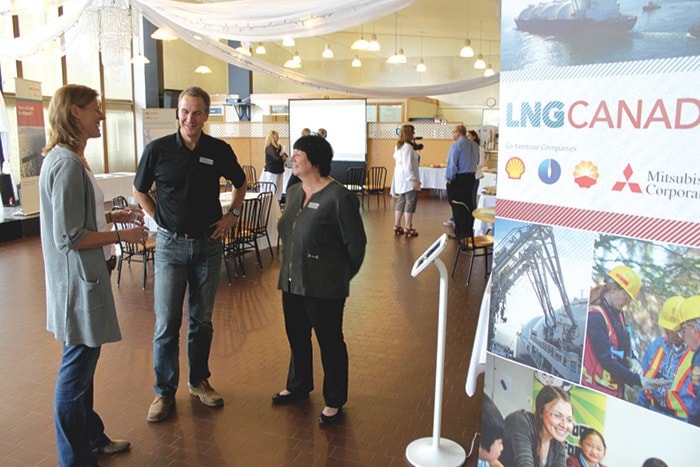IN THE high-stakes race to the coast to develop massive liquefied natural gas (LNG) plants fed by pipelines stretching hundreds of kilometres from northeastern BC gas deposits, industry open houses are playing a critical role.
“Fear is the most dangerous thing that could happen,” says communications manager Katharine Birtwistle, one of a group of officials who set up shop at Northwest Community College the end of June to explain just one project, the Shell majority-owned LNG Canada facility planned for Kitimat.
A provincial survey conducted a few years ago found that a large percentage of B.C. residents didn’t know that LNG stands for liquefied natural gas. Industry execs in foreign countries couldn’t place B.C. on a map.
Shell and Asian partners already have a federal export licence for LNG Canada which carries a price tag of more than $10 billion.
A pipeline to the plant location, which will include the old Methanex site in Kitimat, will cost billions of dollars more. But the project still requires environmental approval and broad public acceptance in advance of Shell and its partners making any kind of final construction decision.
Aside from the plant and pipeline, super-cooling tankers carrying the liquefied product to Asian markets will make their way to Kitimat and much work needs to be done to establish the infrastructure needed to bring the raw product up to the surface from underground deposits in northeastern B.C.
Birtwistle said the LNG Canada project – which is a partnership between Shell Canada, Korea Gas, Mitsubishi and PetroChina – is trying to be as open as possible about both the potential benefits as well as challenges.
Buzz words “openness” and “social acceptance” could be heard around the Northwest Community College room in which Shell and its partners had set up.
According to technical planners at the open house, the biggest challenge is getting in the thousands of workers needed over a four to five year construction phase, with both questions of staffing as well as staff transportation a concern.
LNG Canada has started the needed environmental assessment work and plans to submit its project for a formal review by next year.
Planned emission levels are a factor under consideration because the location is close to the Rio Tinto Alcan aluminum smelter now being rebuilt.
“We are having to look at our own impact along with everyone else’s,” said LNG Canada environmental representative Russell Morrison, saying that with other major industrial facilities nearby there is the need for a cumulative impact assessment. One consideration taken into account is the effect of sulphur dioxide emissions, Morrison said.
Rio Tinto Alcan’s new smelter will emit more sulphur dioxide than its older one but Morrison said that the LNG Canada facility would produce far less.
In northeastern B.C., where LNG Canada will obtain its raw product using hydraulic fracturing from a 300 square mile lease called Groundbirch, work is underway to reduce the environmental footprint.
Gas well operator Carson Newby says Shell has reduced its impact on fresh water sources by using reclaimed water from nearby Dawson Creek.
A representative of LNG Canada partner Mitsubishi, Seiichi Tsurumi, was also on hand. He spoke of the “shale revolution” which has resulted in the ability to retrieve massive deposits of natural gas.
Canada, he said, is viewed as a safe bet by Japanese investors because it is politically and legally stable.
The perception, according to Seiichi Tsurumi, is that “a contract is a contract” in Canada, “and will sustain a transition in government.”
Mitsubishi and two other Asian companies each have a 20 per cent stake in LNG Canada with Shell owning 40 per cent.
Japan is keen to develop a supply of natural gas with the fuel now providing about 30 per cent of Japan’s power. That’s gone up since the meltdown of the Fukushima nuclear plant in the 2011 tsunami.
Ex-LNG carrier captain Craig Jackson was on deck at the open house as well to illustrate Shell’s strategy for navigating the Douglas Channel, saying that currently there are communication blackout areas which would need to be dealt with.
An investment decision, pending environmental approval, isn’t expected until at least 2015 and the plant would not be ready until 2020.
